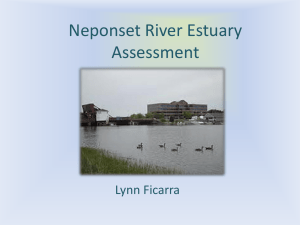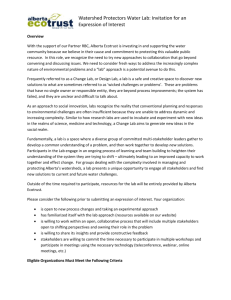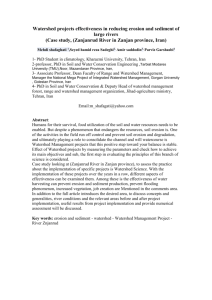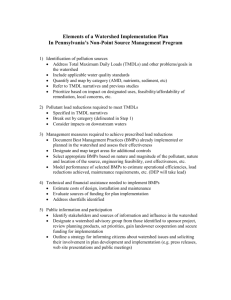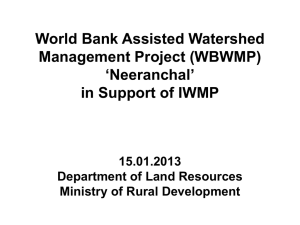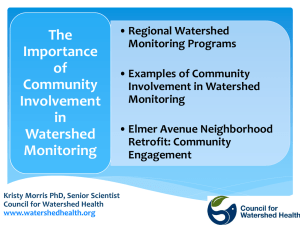Ashley Bulseco-McKim_Phase One - BIOEEOS660-f12
advertisement
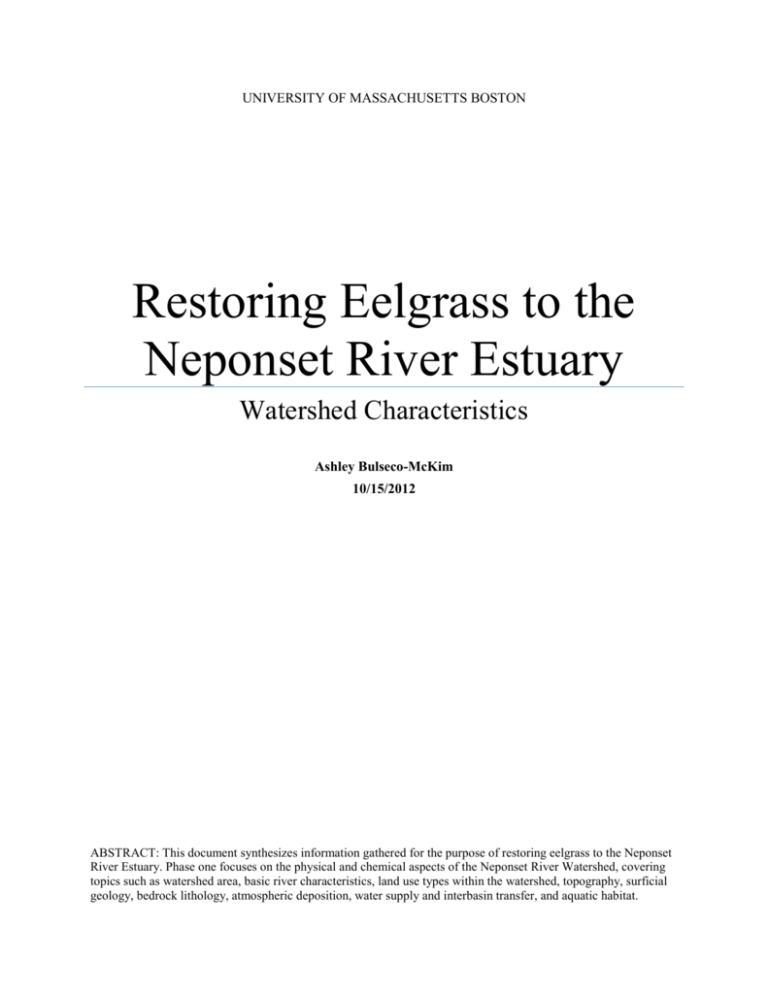
UNIVERSITY OF MASSACHUSETTS BOSTON Restoring Eelgrass to the Neponset River Estuary Watershed Characteristics Ashley Bulseco-McKim 10/15/2012 ABSTRACT: This document synthesizes information gathered for the purpose of restoring eelgrass to the Neponset River Estuary. Phase one focuses on the physical and chemical aspects of the Neponset River Watershed, covering topics such as watershed area, basic river characteristics, land use types within the watershed, topography, surficial geology, bedrock lithology, atmospheric deposition, water supply and interbasin transfer, and aquatic habitat. Watershed Characteristics Bulseco-McKim PROBLEM STATEMENT The Neponset River Watershed has a complex history of social, cultural, and economic development that has led to subsequent deterioration of its receiving estuary. The current goal of this semester’s class is to restore eelgrass to its estuary, in turn improving its overall health. Eelgrass performs a number of ecosystem services, including altered water flow, nutrient cycling, maintaining food web structure, providing a source of food and nursery habitat for upper trophic levels, stabilizing sediments, and contributing to the detritus pool. Unfortunately, multiple stressors, specifically sediment and nutrient run off, have caused massive seagrass decline (Orth et al. 2006). The Neponset River Watershed Association (NepRWA) was originally formed in 1967 as the “Neponest Conservation Association” by a group of people who were concerned about the development and extension of Rt. 95 into Boston. They hold an everlasting commitment to an integrated, water-shed based approach that focuses on the protection and restoration of the physical, biological, and chemical integrity of the Neponset River. This report will help to answer a number of questions posed by the NepRWA, with the ultimate goal of restoring eelgrass and its corresponding ecosystem services to the Neponset River estuary. In order to restore eelgrass to the Neponset River estuary, we must first grasp a number of fundamental characteristics regarding the watershed that feeds it. This report will focus on the physical and chemical aspects of the Neponset River Watershed, covering topics such as (in no particular order) watershed area, basic river characteristics, land use types within the watershed, topography, surficial geology, bedrock lithology, atmospheric deposition, water supply, and aquatic habitat. 1 Watershed Characteristics Bulseco-McKim WATERSHED DELINEATION The Neponset River Watershed (total area = 340-km2) covers the western portion of the Boston Harbor watershed (Fig. 1), draining into the Neponset River and eventually reaching the coastal ocean at Boston Harbor (Zhu & Olsen 2009). The watershed itself consists of 14 cities and towns, including at least parts of Boston, Canton, Dedham, Dover, Foxborough, Medfield, Milton, Norwood, Randolph, Quincy, Sharon, Stoughton, Walpole, and Westwood (Fig. 2), and houses approximately 330,000 people (Neponset River Watershed Association – hereby NepRWA 2004). It is important to note that this calculation was likely performed using data from the 2000 U.S. Census, and will underestimate the current total population within the watershed. Current estimates may be more accurate using the 2010 U.S. Census. From the 1990 to the 2000 U.S. Census alone, population grew by around 6% in towns predominantly comprising the Neponset River Watershed, so it is clear that current population estimates should be used when considering the social aspects of this problem later in the semester. The Neponset River Watershed can be further delineated into sub-watersheds or subregions (Fig. 3). Although they have not been given geographical names, they each correspond to a significant, nearby hydrological feature (e.g. Mill Brook; Table 1). Table 1 provides information on each sub-region, its total area in mi2, and the percent area of forest, residential area, and “other” (NepRWA 1999). This information is useful because it provides a high resolution dataset of land cover, which is important in assessing overall impacts on watersheds and their receiving estuaries (see Land Use/Land Cover, pg. 3). 2 Watershed Characteristics Bulseco-McKim RIVER/STREAMS The headwaters of the Neponset River originate in Foxborough at the Neponset Reservoir, a man-made impoundment (approximately 321 acres). After traveling 30 miles (48km) in a northeasterly direction, the river discharges into Dorchester Bay and Boston Harbor. The river faces impoundment by 12 dams, and passes through a number of private reservoirs before reaching its ultimate destination. There are a number of streams listed in Table 1 according to corresponding town and county, and Fig. 4, which provides a good visualization of the river’s branching patterns (NepRWA). For more details regarding river characteristics, please refer to Sarah Feinman’s assessment report. LAND USE/LAND COVER The Neponset River Watershed consists primarily of five major land cover types (as calculated from MassGIS data and ArcGIS 9.2 by Huang & Chen 2009): 38% of the watershed is residential, 34% is forested (together they make up 72% of the entire watershed land cover), 5% is industry, 4% is wetlands, and 3% is golf courses (Huang & Chen 2009) (Fig.5). It is therefore safe to assume that there are relatively low levels of agriculture and horticulture in this area, and that the primary application of fertilizer will occur upon golf courses and residential lawns/parks. These proportions of land use have undoubtedly shifted dramatically from pre-industrial times to modern day, showing a clear intensification of human alterations with population increase and urbanization (Bhaduri et al. 2000; Paul & Meyer 2008). Change in land use over time is perhaps the most significant human impact on hydrologic systems at the local, regional, and global scale (Bhaduri et al. 2000). Land use alterations have been shown to impact a number of bio- and chemical factors within the watershed, including Dissolved Organic Matter (DOM) 3 Watershed Characteristics Bulseco-McKim quality and quantity (Wiegner & Seitzinger 2004; Huang & Chen 2009), average annual runoff (Bhaduri et al. 2000), species diversity (Minshall et al. 1985), and stream bed erosion (Schlosser 1991). In a study using the Little Eagle Creek watershed (Indianapolis, IN, USA) as a model, an 18% increase in urban or impervious areas led to an approximate 80% increase in annual average runoff and more than 50% in average annual loads for lead, copper, and zinc (Bhaduri et al. 2000). In light of such impacts, it is crucial that we continue to assess land use changes in the Neponset River Watershed (specifically a transition from forested/wetlands to urbanized/impervious areas) and their corresponding ecological consequences. Therefore, we may gain the ability to identify environmentally sensitive areas throughout the watershed, while evaluating alternative land use scenarios to reduce annual runoff and non-point source (NPS) pollution. Considering such a large proportion of the US population lives in metropolitan areas, it is inevitable that urban and industrial areas will continue to expand and human activity will continue to alter the environment (Clark 1967; Chinitz 1991). Understanding the impacts of land use change over a spatial and temporal scale will allow for prediction of environmental consequences and the development potential mitigation strategies. One major consequence of urban development is the increased percentage of impervious surfaces, which can include roads, rooftops, sidewalks, patios, parking lots, and buildings, or any other material that prevents the infiltration of water into the soil (Arnold et al. 1996). These surfaces contribute to the environmental impacts of urbanization by inhibiting the natural process of groundwater recharge, thereby lowering water tables, and resulting in intermittent or dry stream beds during low flow conditions (Harbor 1994). Without the ability to infiltrate the soil, the water instead flows at a greater velocity and volume on the surface, resulting in large sediment deposits and aggravated downstream erosion (Arnold et al. 1996). Additionally, runoff 4 Watershed Characteristics Bulseco-McKim contains a wide array of pollutants, including nutrients, pesticides, pathogens, oil, grease, sediment, and heavy metals, which accumulates from these same impervious surfaces, and eventually feeds into its receiving estuary (Arnold et al. 1996; Bhaduri et al. 2000). Approximately 24% of the Neponset River Watershed’s total acreage consists of impervious surfaces (NepWRA 2004b; Fig. 6); however, the degree of imperviousness inherently differs between and within cities/towns. Much of this variation depends on the total amount of development, and the distribution of land use throughout the watershed. Based on work by the Massachusetts office of Coastal Zone Management (MCZM), the NepRWA described the degree of imperviousness according to land use for the Neponset River Watershed as: 54% imperviousness for Residential Less than ¼ acre, 30% imperviousness for Residential Multi-family ¼ to ½ acre, 30% imperviousness for Residential Multi-family over ½ acre, 58% imperviousness for Commercial/Industrial land use, and 51% imperviousness for Transportation (NepRWA 2004b). Should it then assumed that forest accounts for the remaining percentage of land cover in residential areas? By understanding how impervious surfaces are distributed throughout the Neponset River Watershed, we may gain a better understanding of the degree to which they are impacting the receiving estuary. Studies have found a strong correlation between a drainage basin’s imperviousness and the physical/chemical health of its receiving stream (Klein 1979; Griffin et al. 1980; Schueler 1992), and according to information from the Center for Watershed Protection, expected watershed impacts worsen as percent imperviousness increases. At 0%-10% imperviousness, channels are stable, and support high water quality and excellent biodiversity. At 11-25% imperviousness, there may be some signs of degradation, some channel erosion and widening, some elevated nutrients and pathogens, and fair to good biodiversity. Lastly, at 26% 5 Watershed Characteristics Bulseco-McKim or more imperviousness, there may be stream bank erosion, channel instability, high nutrient levels, low biodiversity, and limited human contact with water supply due to high bacteria levels (NepRWA 2004b). Therefore, we must continue to consistently record percent imperviousness and changes in land use within the watershed as urban development continues at high enough resolution to allow for the continued analysis of watershed impacts. TOPOGRAPHY/LITHOLOGY The topography, surficial geology, and bedrock lithology can also play a role in watershed characteristics by influencing watershed boundaries, and water infiltration, flow, and chemistry, respectively (Fetter 2001). The topography of the Neponset River Watershed is fairly mild, with the steepest topography occurring at Buck Hill (Quincy; 496 ft), Chickatawbut Hill (Milton; 470 ft), Houghton Hill (Milton; 420 ft), Tucker Hill (Quincy; 499 ft), and Wolcott Hill (Milton; 470 ft) (http://www.franklinsites.com; note, site may not be reputable). The Neponset River Watershed is delineated using these topographical features, and is defined separately from Boston Harbor Watershed’s other sub-watersheds (Fig. 1). Precipitation that falls onto a watershed may travel as surface runoff, shallow interflow, flow through surficial features, or groundwater through bedrock fractures (Newton et al. 1987). Surficial geology of the Neponset River Watershed consists primarily of sand and gravel, large sand deposits, and to a lower extent, floodplain alluvium (OLIVER MassGIS). Sand and gravel ranges from 20-35% porosity, or the percent of void spaces between solid fragments, and between 10-2 to 103 intrinsic permeability (in darcys), representing the degree of ease with which a porous medium can transmit a liquid under a potential gradient. It is also tends to have a higher hydraulic conductivity, which is a coefficient that helps to define the rate at which water can 6 Watershed Characteristics Bulseco-McKim move through a permeable medium (Fetter 2001). These characteristics suggest that water will be capable of infiltrating the surface soil in the absence of impervious surfaces; although, more research should be conducted on the available literature to gain a better understanding of the interaction between surficial geology and water flow. This could have tremendous implications on the vertical and horizontal movement of groundwater, as well as velocity, which will eventually translate to groundwater discharge impacts to the Neponset River Watershed streams and estuary. Bedrock lithology, or mineral composition/classification of rocks, can also play a role in defining water flow and water chemistry. The Neponset River Watershed is comprised of primarily granite (which groundwater cannot infiltrate), basin sedimentary rock, and metamorphic rock near the coastline. The extent of fractures within the bedrock and the degree of porosity can ultimately influence the residence time of the water underground, while the mineral composition can lead to a number of chemical transformations of the groundwater itself. These characteristics can further be applied to the analysis of water quality in both surface water and shallow groundwater, along with the investigation of stream sediments in regards to bedrock lithogeochemistry (Fetter 2001). Additionally, rare earth elements (REE) have been used to study a variety of geological processes regarding chemical weathering and water-rock interactions (Hannigan 2005). Again, more research needs to be conducted on the existing literature to understand the complex interaction between bedrock lithology and water features to further characterize the essential information required to restore eelgrass to the Neponset River estuary. 7 Watershed Characteristics Bulseco-McKim WATER SUPPLY AND INTERBASIN TRANSFER Approximately 220,000 people use water that at least partly depends on groundwater from the Neponset Valley (NewRWA). Of that pumped water, 21% is pumped back into the Neponset River Watershed as septic system effluent, and 65% is relocated outside the basin via sewer systems (NepRWA 1998). Along the way, water is lost to a number of sources; however, aging sewage infrastructure exacerbates the extent to which groundwater is lost by leaking and infiltration (NepRWA 2004b). Due to these losses, the Neponset experiences an annual net loss of 9 billion gallons water per year, a volume approaching ¼ of the river’s annual discharge. The NepRWA attributes this extensive net loss to a number of factors: 1. The extension of sewer lines for service of both new and existing development (formerly septic), 2. The municipal development of new water supply sources throughout the Neponset River Watershed to sustain increasing water demand due to population rise or increased per capita demand, 3. The development of new Neponset water supply sources instead of MWRA (due to a rise in cost and compliance with the Federal Safe Drinking Water Act), and 4. The installation private irrigation wells in attempts to avoid compliance with water use restrictions opposed during periods of drought (NepRWA 2004b). Table 4 presents current Neponset Municipal Water Supply Sources and Wastewater Infrastructure according to town as either ‘Neponset’, ‘MWRA’, or ‘other’. It is interesting to see the different trends in water supply dependence (e.g. Canton relies heavily on the MWRA while Sharon relies more so on their local supply). An important social aspect of this project to be researched further is the individual attitudes and rationale from each town, leading to patterns in water usage and dependence. There is also a knowledge gap (especially in my own knowledge) in wastewater infrastructure and its current status (e.g. pipe integrity and age) throughout our 8 Watershed Characteristics Bulseco-McKim watershed per municipal. We need to determine the distribution of sewage or septic systems (perhaps in light of Title V to consider social aspects), evaluate the extent of failing sewage systems, and further research processes of inflow and infiltration to the best of our ability, although a number of assumptions will have to be made due to the lack of availability of this type of information. These steps will help us to determine rates and distribution of sewage disposal, calculate inputs lost to sewage and septic systems (e.g. nitrogen loads), and investigate a number of other environmental impacts of NPS pollution. ATMOSPHERIC DEPOSITION Atmospheric deposition is the transfer of pollutants from the air to the earth’s surface (EPA 2012), and can occur in two methods: wet deposition and dry deposition. Wet deposition is when aerosols or other gases are dissolved/suspended in precipitation (e.g. rain, snow, sleet). This can typically be measured directly by analyzing trace quantities of pollutants via Inductively Coupled Plasma Mass Spectrometry (ICP-MS), or other analytical instrumentation, and multiplying the resulting concentration by the total volume of precipitation over a specified time period. Dry deposition, on the other hand, consists of suspended particles or gaseous contaminants which gravitationally settle onto land or water surfaces. Once deposited onto the earth’s surface, the contaminants quickly adsorb to vegetation, soils, or any other surfaces present in that given area (Zhu & Olsen 2009). As suggested by a smaller volume of literature, dry deposition is more difficult to directly measure. Generally, investigators will collect particles using an artificial surface that represents a naturally occurring surface, or will take the concentration of contaminants present in the air and multiply that by the values of deposition velocities as found in the current literature (Golomb 1999). 9 Watershed Characteristics Bulseco-McKim In the Valiela et al. 1996 article we covered in class, authors created and implemented a model to estimate nitrogen loading from a coastal watershed to its receiving estuary. Nitrogen loading to the coastal waters is of major concern, particularly because primary production is limited by nitrogen availability (Valiela 1995; Howarth 1988). As a result, it is not only important to enumerate nitrogen loading from fertilizer and wastewater disposal, but it is also important to know how much of that nitrogen is being deposited in residential areas (impervious surfaces), forests, or various other surfaces via wet and dry atmospheric deposition. In the WBLMER model, atmospheric deposition was estimated to be twice that wet deposition (in kg N ha-1 yr-1) due to the lack of studies covering dry deposition. A handful of studies have investigated the rate of dry deposition in the Boston area (e.g. Zhu & Olsen 2009 looked at 7Be deposition from the roof of UMass Boston; Golomb 1999 looked at toxic metals Cd, Co, Al, Cr, Cu, Fe, Mn, Ni, Ph, Zn, Hg biweekly in Massachusetts Bay); however, I suggest a number of atmospheric deposition studies be conducted directly in our estuary. Because a large portion of the Neponset “airshed” is urban, to what extent will dry deposition contribute to total atmospheric deposition as a whole? It is clear that atmospheric deposition plays an important role in loading of various trace metals and pollutants to the coastal ocean (Valiela et al. 1996); however, it must be readily monitored over long time scales in order to capture its spatial and temporal variability. Rates of wet deposition depend on precipitation and its particular chemistry, while rates of dry deposition depend on wind velocity and direction. Therefore, an understanding of climate is required to fully interpret effects of atmospheric deposition – climate has not been fully discussed in this assessment report, but Table 3 provides the precipitation rates (inches per month) for East Boston and Milton (representing the NE Region) and Foxborough and Milton (representing the 10 Watershed Characteristics Bulseco-McKim SE Region). More detailed climate characteristics, including information regarding wind, should be further researched. USGS or NOAA NCDC will likely report reliable data from which we can infer climate and atmospheric deposition rates. AQUATIC HABITAT The final link in the watershed chain is the conservation of aquatic habitats, including wetlands, vernal pools, riparian shoreline buffers, and other vegetated landscapes, all of which serve a number of critical functions to the maintenance of natural stream processes. As development continues to transition forested land to urban areas, the physio-chemical relationships with adjacent streams and brooks are altered and their integrity compromised (Roth et al. 1996). It is therefore crucial that we synthesize studies regarding the effects of physical/chemical alterations on aquatic habitat integrity. The Neponset River Watershed in particular houses a number of special habitat types (for sake of brevity, see maps in NepRWA (2004b) pg. 66-72). Various habitats include the BioMap core map, which focuses NHESP (Natural Heritage and Endangered Species Program) listed rare species and communities, estimated habitats for rare wildlife, priority habitats for state protected rare species, living water core habitats, as well as anadromous fisheries, vernal pools, areas of critical environmental concern, outstanding resource waters, cold and warm water fisheries, and wetlands. According to the Massachusetts Executive Office of Environmental Affairs (EOEA), key topics to further research include salt marshes, wetland wildlife habitat, flood storage, invasive species, cold water fisheries, and groundwater recharge and stream baseflow (NepRWA 2004b). These aquatic habitats face degradation, primarily due to channelization, removal of 11 Watershed Characteristics Bulseco-McKim riparian buffer zone, thermal modification as a result of impoundments, and dumping into the habitats themselves. The final type of aquatic habitat denoted by the NepRWA is called “open space,” which is protected through the ownership of a governmental or non-profit organization. This habitat type allows for rain water to infiltrate the groundwater and recharge underground aquifers, while also providing shelter for hundreds of species of plants and animals – the NepRWA reported over 900 species of “visible” species in one town alone. The Neponset River Water has approximately 20.7% of the total acreage that is considered open space, with an additional 4.3% owned with private, for-profits. Future research should consider assessing various habitats, and determining if they may be intact enough to be acquired as permanent open space. At this point, the NepRWA doesn’t know how much of the watershed’s land can be labeled as permanent, and hasn’t determined how much land is available for open space acquisition (NepRWA 2004b). It can only be assumed that while population growth is inevitable, so is land development. As more and more land is used, the total acreage of open space will be lost. Further assessments should take into account the ecological importance of these habitats, and emphasize the need for open space throughout the Neponset River Watershed. CONCLUSION To restore eelgrass to the Neponset River Estuary, a number of characteristics need to be further researched (either within the current literature, or through newly designed experiments). These include 1. continued monitoring of land use changes over time to understand and predict ecological consequences incurred by sensitive environmental areas, 2. continued monitoring of imperviousness, 3. an investigation of the relationship between topography and bedrock 12 Watershed Characteristics Bulseco-McKim lithology to understand how groundwater flow and chemistry may be affected, 4. a survey of wastewater infrastructure of municipals included in the Neponset River Watershed and the overall status of these systems, 5. An investigation into atmospheric deposition processes affecting the Neponset River Watershed (with a particular focus on dry deposition), and 6. An assessment of available open space throughout the watershed and its potential for acquisition and conservation. 13 Watershed Characteristics Bulseco-McKim References Arnold Jr CL, Gibbons CJ (1996) Impervious surface coverage: the emergence of a key environmental indicator. Journal of the American Planning Association 62:243-258 Bhaduri B, Harbor J, Engel B, Grove M (2000) Assessing watershed-scale, long-term hydrologic impacts of land-use change using a GIS-NPS model. Environmental Management 26:643-658 Chinitz B (1991) A framework for speculating about future urban growth patterns in the US. Urban Studies 28:939-959 Clark C (1967) Population growth and land use. Population growth and land use EPA (2012) Atmospheric Deposition of Toxic Pollutants. http://www.epa.gov/glindicators/air/airb.html Fetter C (2001) Applied Hydrogeology. Prentice Hall New Jersey Golomb D, Ryan D, Eby N, Underhill J, Zemba S (1997) Atmospheric deposition of toxics into Massachusetts Bay-I metal. Atmos Environ 31:1349-1359 Griffin Jr D, Grizzard T, Randall C, Helsel D, Hartigan J (1980) Analysis of non-point pollution export from small catchments. Journal (Water Pollution Control Federation):780-790 Hannigan R (2005) Rare earth, major, and trace element geochemistry of surface and geothermal waters from the Taupo Volcanic Zone, North Island New Zealand. Rare Earth Elements in Groundwater Flow Systems 51:67-88 Harbor JM (1994) A practical method for estimating the impact of land-use change on surface runoff, groundwater recharge and wetland hydrology. Journal of the American Planning Association 60:95-108 Howarth R (1988) Nutrient limitation of net primary production in marine ecosystems. Annual Review of Ecology and Systematics 20:256-260 Huang W, Chen RF (2009) Sources and transformations of chromophoric dissolved organic matter in the Neponset River Watershed. Journal of Geophysical Research 114:G00F05 Klein RD (1979) Urbanization and stream quality impairment. Journal of the American Water Resources Association 15:948-963 Lovett GM (1994) Atmospheric deposition of nutrients and pollutants in N. America: an ecological perspective. Ecol Appl 4:629-650 14 Watershed Characteristics Bulseco-McKim Minshall GW, Cummins KW, Petersen RC, Cushing CE, Bruns DA, Sedell JR, Vannote RL (1985) Developments in stream ecosystem theory. Canadian Journal of Fisheries and Aquatic Sciences 42:1045-1055 Neponset River Watershed Association (1998) Neponset Basin Water Use Efficiency Report. Neponset River Watershed Association (2004) Boston Harbor South Watersheds 2004 Assessment Report. Urban Harbors Institute Publications. http://www.neponset.ord/Low%20Resolution/BostonHarborAssesLoRes.pdf Neponset River Watershed Association (2004) Neponset River Watershed 2004 Assessment Report. University of Massachusetts, Urban Harbors Institute. http://www.neponset.org/BasinPlan/Low%20Resolution/NeponsetAssessLoRes.pdf> Neponset River Watershed Association (2010) Neponset River Watershed. Accessed October 12, 2012. http://www.neponset.org/Watershed.htm Neponset River Watershed Association (2006) Neponset River Watershed Association strategic plan, 2006-2011. http://www.neponset.org/Reports/NepRWAStrategicPlan06-11.pdf Neponset River Watershed Association (1999) Neponset River Subwatershed-River and Estuary Segment Assessments. http://www.mass.gov/dep/water/resources/70wqar3b.pdf Neponset River Watershed Association (2004) Neponset River Watershed 2004 Water Quality Assessmnet Report. http:..www.mass.gov/dep/water/resources/wqassess.htm Neponset River Watershed Association, and Executive Office of Environmental Affairs. 1997. Neponset River watershed basin-wide action plan. Boston, MA. Newton RM, Weintraub J, April R (1987) The relationship between surface water chemistry and geology in the North Branch of the Moose River. Biogeochemistry 3:21-35 Orth RJ, Carruthers TJB, Dennison WC, Duarte CM, Fourqurean JW, Heck Jr KL, Hughes AR, Kendrick GA, Kenworthy WJ, Olyarnik S (2006) A global crisis for seagrass ecosystems. Bioscience 56:987-996 Pack DH (1980) Precipitation chemistry patterns: A two-network data set. Science 208:11431145 Paul MJ, Meyer JL (2008) Streams in the urban landscape. Urban Ecology:207-231 Schlosser IJ (1982) Fish community structure and function along two habitat gradients in a headwater stream. Ecological Monographs 52:395-414 Schueler TR (1992) Mitigating the adverse impacts of urbanization on streams: A comprehensive 15 Watershed Characteristics Bulseco-McKim strategy for local government. Watershed Restoration Sourcebook, Publication 92701:2131 Valiela I (1995) Marine ecological processes. Second edition. Springer-Verlag, New York, New York, USA Valiela I, Collins G, Kremer J, Lajtha K, Geist M, Seely B, Brawley J, Sham C (1997) Nitrogen loading from coastal watersheds to receiving estuaries: new method and application. Ecological Applications 7:358-380 Wang L, Lyons J, Rasmussen P, Seelbach P, Simon T, Wiley M, Kanehl P, Baker E, Niemela S, Stewart PM (2003) Watershed, reach, and riparian influences on stream fish assemblages in the Northern Lakes and Forest Ecoregion, USA. Canadian Journal of Fisheries and Aquatic Sciences 60:491-505 Wiegner, TN, Seitzinger SP (2004) Seasonal bioavailability of dissolved organic carbon and nitrogen from pristine and polluted freshwater wetlands. Limnol Oceanogr 49:1703– 1712 Zhu J, Olsen CR (2009) Beryllium-7 atmospheric deposition and sediment inventories in the Neponset River estuary, Massachusetts, USA. J Environ Radio 100:192-197 16 Watershed Characteristics Bulseco-McKim FIGURES Fig. 1. Delineation of Boston Harbor Watershed, including the City of Boston Watershed, Fore River Watershed, Back River Watershed, Weir River Watershed, and Neponset River Watershed (NepRWA 2004a). Fig. 2. Delineation of the Neponset River Watershed and relevant town/city boundaries (NepRWA 2004b) 17 Watershed Characteristics Bulseco-McKim Fig 3. River and estuarine segments in the Neponset River Subwatershed. Fig. 4. Streams and major ponds of the Neponset Watershed (NepRWA 2004), from which subregions are hydrologically linked. 18 Watershed Characteristics Bulseco-McKim Table 1. List of streams/brooks associated with subwatersheds within the Neponset River Watershed. Segment #’s can be referenced in Fig. 3. Total area given in mi2, and area of forest, residential, and other given in total percent (NepRWA 1999) Subwatershed School Meadow Brook Tubwreck Brook Mill Brook Mine Brook Unnamed tributary Mill Brook Bubbling Brook Unnamed tributary Unnamed tributary Germany Brook Hawes Brook Unnamed tributary Traphole Brook Neponset River Unnamed tributary Steep Hill Brook Beaver Brook Unnamed tributary Massapoag Brook Pequid Brook E. Branch Nep. River Plantingfield Brook Purgatory Brook Pencuit Brook Ponkapoag Brook Neponset River Mother Brook Pine Tree Brook Neponset River Unquity Brook Gulliver Creek Neponset River City Seg. # Walpole MA73-06 Dover MA73-07 Medgield MA73-08 Walpole MA73-10 Walpole MA73-09 Westwood MA73-12 Walpole/Westwood MA73-11 Walpole/Westwood MA73-13 Norwood MA73-14 Norwood MA73-15 Norwood MA73-16 Norwood MA-73-33 Sharon/Norwood MA73-17 Foxboro/Canton MA73-01 Stoughton MA73-32 Canton MA73-18 Sharon/Norwood MA73-19 Sharon/Norwood MA73-31 Sharon/Canton MA73-21 Canton MA73-22 Canton MA73-05 Westwood/Norwood MA73-23 Westwood/Norwood MA73-24 Canton MA73-25 Canton MA73-27 Canton/Boston MA73-02 Dedham/Boston MA73-28 Milton MA73-29 Milton/Boston MA73-03 Milton MA73-26 Milton MA73-30 Boston/Quincy MA73-04 19 Area (mi2) Forest (%) Residential (%) Open Land (%) 1.7 1.6 2.3 3.0 1.1 3.1 1.1 0.0 0.4 2.0 1.1 0.7 3.5 13.7 1.0 1.0 3.5 0.2 4.0 3.8 3.2 2.0 4.9 1.7 3.2 7.9 3.1 4.7 3.7 1.4 0.0 1.0 59 58 58 55 51 54 83 54 46 50 45 70 42 40 55 56 58 43 44 42 40 42 35 37 34 37 59 47 37 62 x x 15 33 33 33 32 39 23 34 37 30 37 14 32 35 22 23 27 33 37 28 37 31 33 23 25 35 14 41 36 15 x x 7 5 5 5 5 3 14 7 7 10 7 8 10 8 8 8 7 6 7 9 7 10 11 20 17 8 12 8 9 14 x x Watershed Characteristics Bulseco-McKim Table 2. List of stream segments within the Neponset River Watershed, separated by town/county (NepRWA 2004b). Town County Stream Segments Boston Canton Suffolk Norfolk Mother Brook; Neponset River middle and lower mainstems and estuary Beaver Meadow Brook; East Branch mainstem (aka Canton River), Massapoag Brook; Neponset River middle mainstem; Pecunit Brook; Pequit Brook; Ponapoag Brook Dedham Dover Foxboro Medfield Milton Norfolk Norfolk Norfolk Norfolk Norfolk Mother Brook, Neponset River middle mainstem Mill Brook (off Germany Brook) and Mill Brook (off Mine Brook) Neponset River upper mainstem, School Meadow Brook Mine & Mill brooks Gulliver Creek; Neponset River middle & kiwer mainstem and estuary; Pine Tree Brook; Unquity Brook Norwood Norfolk Germany Brook; Hawes Brook; Meadow Brook; Neponset River upper & Middle mainstem; Plantingfield Brook; Purgatory Brook; Traphole Brook Quincy Randolph Sharon Norfolk Norfolk Norfolk Neponset River estuary; Gulliver Creek Pequit Brook, Ponkapoag brook Massapoag & Beaver Brooks; Steep Hill Brook; School Meadow Brook , Traphole Brook Stoughton Walpole Norfolk Norfolk Beaver Meadow Brook; Steep Hill Brook Mine Brook, Neponset River upper mainstem; School Meadow brook; Spring Brook; Traphole Brook Westwood Norfolk Germany Brook, Mill Brook (off Germany Brook); Neponset middle mainstem; Plantingfield Brook; Purgatory Brook 20 Watershed Characteristics Bulseco-McKim Fig. 5. Land use within the Neponset River Watershed. Residential area, forested area, industry, wetlands, and golf courses are the five major types of land cover according to Huang & Chen 2009 (NepRWA 2004b) 21 Watershed Characteristics Bulseco-McKim Table 3. Precipitation rates (inches per month) for East Boston and Milton (representing the NE Region) and Foxborough and Milton (representing the SE Region) from <http://www.mass.gov/dcr/watersupply/rainfall/precipdb.htm>. 22 Watershed Characteristics Bulseco-McKim Table 4. Neponset Municipal Water Supply Sources and Wastewater Infrastructure (NepRWA 2004b) Water Supply Sources Town Neponset MWRA Boston None 100 Canton 44 56 Dedham 71 None Dover 66 None Foxboro 58 None Medfield 79 None Milton None 100 Norwood None 100 Quincy None 100 Sharon None None Stoughton 47 None Walpole 45 None Westwood 100 None TOTAL 71 34 Other None None 29 34 42 33 None None None 53 55 None 29 19 23 Wastewater Infrastructure Septic MWRA Other None 100 None 30 70 None 8 92 None 100 None None 95 None 5 67 None 33 10 90 None 2 98 None None 100 None 98 None 2 36 61 None 36 64 None 13 87 None 21 56 23
